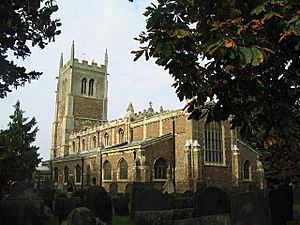- This page was last modified on 17 October 2025, at 10:18. Suggest an edit.
St Peter & St Paul's Church, Syston facts for kids
| St Peter and St Paul’s Church, Syston | |
|---|---|

St Peter and St Paul’s Church, Syston
|
|
| 52°42′1.92″N 1°4′29.68″W / 52.7005333°N 1.0749111°W | |
| Location | Syston |
| Country | England |
| Denomination | Church of England |
| History | |
| Dedication | St Peter and St Paul |
| Architecture | |
| Heritage designation | Grade I listed |
| Administration | |
| Parish | Syston |
| Deanery | Goscote |
| Archdeaconry | Leicester |
| Diocese | Diocese of Leicester |
St Peter and St Paul's Church in Syston is a very old and important church. It's located in Syston, Leicestershire, England. This church is part of the Church of England. It's also a 'Grade I listed' building, which means it's a special historical site.
Contents
History of the Church
Early Beginnings
The oldest parts of this church were built a long, long time ago, in the 13th century. That's over 800 years ago!
Restoration Work
The main part of the church, called the nave, and its tall tower were fixed up. This work was done by Frederick Webster Ordish from Queniborough. The repairs cost about £1,600. The church reopened in February 1872 after these important repairs.
Later, in 1880, the chancel was rebuilt. The chancel is the part of the church near the altar. This work cost £2,300. Special stones were used for the walls and pillars. These included Duston stone, Clipstone, and Bath stone. The floor was made with Portland and red Mansfield stone. Thomas Earp of London did the detailed carvings. The newly rebuilt chancel reopened on 27 May 1881.
Church Organ
The church has a beautiful organ. It was built in 1887 by a company called Taylor of Leicester. You can find more details about this organ on the National Pipe Organ Register.
Parish Status and Team
This church is part of a group of churches called The Fosse Team. A parish is like a local area that a church serves. Being part of a "team" means these churches work together.
The churches in The Fosse Team are:
- St Mary's Church, Barkby
- St Hilda's Church, East Goscote
- Holy Trinity Church, Thrussington
- St Botolph's Church, Ratcliffe-on-the-Wreake
- St Michael and All Angels’ Church, Rearsby
- St Mary's Church, Queniborough
- St Michael and All Angels’ Church, Thurmaston
